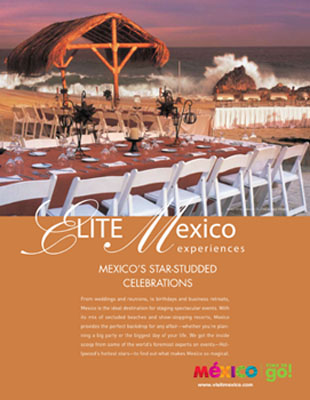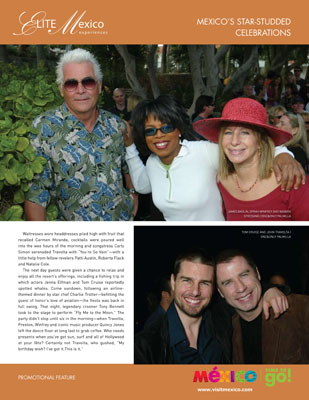
| The last of the trio of Elite Mexico Experiences advertisements, although similar to the other ads within the campaign mentioned earlier for its use of images and text, also offers a different approach to describing the star-studded celebrations present at Mexico's most coveted beaches. Within this advertisement, the Mexican tourism board recounts the stories of various celebrity parties and weddings at five star resorts. They suggest that "from weddings and reunions, to birthdays and business retreats, Mexico is the ideal destination for staging spectacular events. With its mix of secluded beaches and show-stopping resorts, Mexico provides the perfect backdrop for any affair-whether you're planning a big party or the biggest day of your life" (Elite Traveler 70). |  |
| In addition to the
introductory narrative of the luxurious fun to be had while along the
beaches of Mexico, the advertisement utilizes text to describe John
Travolta's 50th birthday blow out with the likes of Oprah, Barbara
Streisand, Tom Cruise, Scarlett Johansson and Sylvester Stallone,
amongst other celebs in attendance at the One & Only Palmilla resort in
Los Cabos (pictured right).The last of the trio of Elite Mexico
Experiences advertisements, although similar to the other ads within the
campaign mentioned earlier for its use of images and text, also offers a
different approach to describing the star-studded celebrations present
at Mexico's most coveted beaches.
|   |
| In
his work concerning how "clusters of stereotypical cliches and images
form associations with specific locations, sociologist, Rob Shields,
suggests a definition for such occurrences, he calls it a place-myth.
He also suggests that "these stereotypes need not have any direct
relation to the actual topographical and social realities of that place
but they form peoples' expectations and ideas of that site" (Lubbren
133). It is important to introduce the pertinent role that images play
in being able to "constitute crucial components of a place-myth. An
image can evoke a particular association or category of place in a
powerful synecdochal and iconic way" (Crouch, Lubbren 5). What he means
by this is that images can summon up an entire site and arrangement of
experience by representing only a piece. The images within this ad
feature only a piece of the entire setting from which a picture was
taken. If we look at the picture displaying a white table cloth and
place settings, we note that this is only one framing of the entire
reception set-up, but this piece is enough to connote an entire
celebration experience. In analyzing this grouping of text and images one can see how certain stereotypical cliches of text, but most importantly images, correlate with specific locations. For purposes of continuing the work of Rob Shields, I will refer to the images of this advertisement as representative of what he deems as forming place-myths. The images present within the advertisement crowd together images of rocky green coastlines, palm trees, sandy beaches, waves crashing against rocks, palapas, and sunsets displaying a pink backdrop at the sea side. These represent perfect examples of the "stereotypical cliches that these images utilize to connote exotic beach locations. Sandy beaches, sunsets, and palapas become signifiers of Mexican beach experiences, thus offering a place-myth to advertisement onlookers. Nina Lubbren, in her article entitled: North to South: Paradigm Shifts in European Art and Tourism, 1880-1920, extends Shields use of place-myths to incorporate tourists' views of them. She suggests that "tourists draw on place-myths for the choice and the subsequent experience of a holiday destination". The experience and formation of a place worthy of holidaying is thus expressed within the advertisement's cliche images of sandy beaches, sunsets, and palapas that have become common signifiers of beach holidays. These examples are similar to Lubbren's mentioning of "the discovery of sun and the tan as principle ingredients in holidaymaking" that was closely linked to certain place-myths (134) in her commentary concerning beach culture of the early 1900's. With this said, she has beautifully explained how the Elite Mexico Experiences ad about beach celebrations, makes attempts at painting a picture of a place-myth with the inclusion of cliche ingredients (palapas, sun, tan, sand) to be internalized by tourists as signifiers of the experiences to be had at Mexican beach resorts, whether they are present or not, it is what to be expected. Through the production of this advertisement, the Mexico Tourism board (like landscape painters of place-myths mentioned by Lubbren), has participated "actively in the construction, and through their pictures, the dissemination of place-texts" (133). Consequently, these painted place-myths "could be instrumental in enticing further visitors to a particular destination, and this influx of outsiders could, in turn, generate enough entrepreneurial activity at the local level to transform a village into a tourist site" (Lubbren 133). I think we can all agree that Mexico in this case, holds enough examples of resorts cities, like Cancun and Acapulco (mentioned in the ad) that gained such touristic growth from the dissemination of place-myths, promulgated through advertisements such as this ad.
|